If you are visiting London, you might be wondering whether it’s worth taking the river Thames cruise. While the boat tour offers spectacular views and informative commentary, it may not be the best fit for everyone. In this article, I go through all the pros and cons of the Thames cruise, as well as provide information on what landmarks and bridges you will see.
I hope this article helps you to make an informed decision about whether the Thames river cruise is the right experience for you.

This post contains affiliate links, which means I’ll receive a commission if you purchase through my link, at no extra cost to you.
Is the Thames River Cruise Worth it?
If you are visiting London for the first time, I think it’s a good idea to spend some time visiting the Thames. The famous river Thames is very important to London, and is what made it the thriving capital city it is today. Due to this, many major and important landmarks exist along its banks.
Below you can find 9 reasons why you might want to take the river cruise, and 3 reasons why you might want to avoid it. I have also listed all the landmarks and bridges that the cruise travels past, so you know what to expect.

Pros of Taking a River Thames Cruise
Here are nine reasons why I think a river cruise is worth it.
1. Spectacular Views
A Thames cruise offers some of the most stunning views of London’s iconic landmarks, such as the Houses of Parliament, Tower Bridge, and the London Eye, from a unique and beautiful vantage point.
2. Informative Commentary
London’s tour guides are renowned for their humour, and the crew on board the Thames cruise is no exception. Their live commentary about the sites you’ll see is both informative and entertaining.

3. Comfort and Convenience
Taking a Thames cruise is a stress-free way to explore London’s most famous landmarks. You can sit back, relax, and take in the views without worrying about getting lost, traffic, or public transport.
4. Relaxation and Tranquility
The gentle motion of the boat, provides a relaxing and peaceful experience. You can escape the hustle and bustle of the city and enjoy some downtime, surrounded by some of London’s most iconic landmarks.
5. Suitable for All Ages
The cruise is suitable for people of all ages, making it a great family activity that can be enjoyed by everyone. It can also be fun for children to see some of the Thames wildlife, like the cormorants pictured below.

6. London from a Different Angle
The Thames cruise offers a different perspective of London, as you see many major landmarks from a different angle. You also get to travel under eight different bridges.

7. Cost-Effective
Compared to other tourist activities in London, a Thames cruise is relatively affordable. It’s great value for money, especially considering the stunning views and unique experience it offers.
8. Different Options
There are many different Thames cruise options to choose from, such as a river cruise with lunch, afternoon tea or dinner. You can also choose to get a cruise from Westminster to Tower Bridge, or carry on to Greenwich. The photograph below shows one of the dinning options on the Thames.

9. Foreign Language Audio Commentary
For non-English speaking visitors, a Thames cruise is a great way to experience the city. The boats offer audio commentary in multiple languages, including French, Spanish, Italian, and German.

Cons of Taking a Thames Cruise
Here are three reasons why a river cruise might not be the best option for you.
1. Weather Dependence
The quality of your experience can be significantly impacted by the weather. If it’s raining or very windy, you may not be able to enjoy the views or commentary as much as you would on a sunny day.
I took the cruise on a cloudy day in March (as you can see from the photos). If it was raining I think the lower deck, which is under cover, would have been crowded which would have impacted the experience.
2. Crowds
Thames tours are popular tourist attractions, which means that they can get crowded, especially during peak season. This can make it difficult to find a good spot on the boat and can also make the wait to board the boat uncomfortable because there isn’t much space on the pier.
3. Uncomfortable Seats
If you have a back problem and require a supportive chair, you should be aware that the seats on the boat offer no support whatsoever. The backs of the chairs are also low so you can’t lean back unless you are slouching. I don’t have a back problem and found them uncomfortable. This might be something to bear in mind if you choose one of the cruises which lasts more than 30 minutes.

Landmarks on the Route
The Thames River Cruise passes by twenty two different landmarks, which include major attractions like the Tower of London and St Pauls Cathedral. You can find out more about each of these landmarks below.
1. The Houses of Parliament
The cruise starts at Westminster Pier which is located close to the Palace of Westminster. This is the meeting place of both the House of Lords, and the House of Commons, known collectively as the Houses of Parliament.
The site has a long history, dating back over 900 years. Although some of its original medieval structure remains, most of it was destroyed by a fire in 1834.

2. County Hall
This historic building, located on the south bank of the River Thames, served as the headquarters of the London County Council until 1986, when it was disbanded by the national government.
The building was then left almost vacant for seven years, until it was bought by a Japanese firm who turned it into an entertainment centre. Today, it houses the London Aquarium and the London Dungeon.
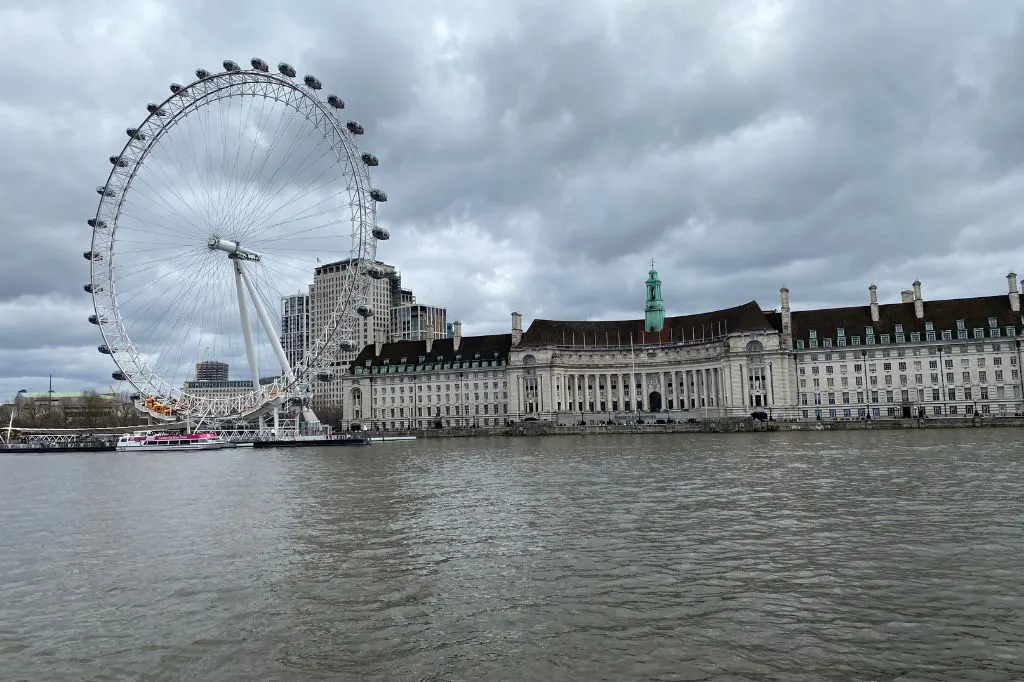
3. The London Eye
The giant Ferris wheel, on the south bank of the River Thames, is known as the London Eye. Since it opened in 2000 to celebrate the millennium, it has become one of London’s most popular tourist attractions. It has 32 capsules, one for each of the 32 London boroughs, and offers stunning views of the city.

4. Ministry of Defence
This building, located in Whitehall on the north bank of the river, is the headquarters of the armed services in the United Kingdom. This includes the British Army, Royal Navy and Royal Air Force.

5. Southbank Centre
The Southbank Centre was created in 1951 for the Festival of Britain. Today it houses several venues for music, dance, literature, and visual arts. It hosts a variety of events and festivals throughout the year.
6. Cleopatra’s Needle
This ancient Egyptian obelisk, located on the Victoria Embankment, was originally erected in Egypt around 1450 BC. It was gifted to the United Kingdom by Muhammad Ali of Egypt in 1819, in recognition of Nelson’s victory over the French Fleet at the Battle of the Nile in 1798.

7. Savoy Hotel
The Savoy Hotel was built on the site of the Savoy Palace, and was London’s first luxury hotel. It has hosted many famous guests, including Winston Churchill, Charlie Chaplin, and Marilyn Monroe.

8. Royal National Theatre
The Royal National Theatre has been described as Britain’s ugliest building. It opened in 1976, and contains three different theatres, as well as a restaurant and bookshop.

9. Somerset House
Somerset House is a magnificent neoclassical building situated on the north bank of the River Thames. It takes its name from the Duke of Somerset who built a palace on this site in the 16th century. The building is known today for being the venue of London Fashion Week. In the winter time it is also home to a popular ice rink.

10. The Temple
The Temple is the area of London around Temple Church. The name comes from the Knights Templar which was founded in 1100 for the protection of pilgrims travelling to the holy land.
This area of London is one of the main legal districts, and a centre for English law. It includes two of the four Inns of Court, the Middle Temple and the Inner Temple. The other two are Gray’s Inn and Lincoln’s Inn.
11. The OXO Tower
The OXO Tower is a famous landmark on London’s Southbank that was originally a power station. It was rebuilt in the in the 1920s by the makers of Oxo stock cubes. At the time, advertising along the Southbank skyline was banned, so instead the company constructed windows in the shape of a two circles and a cross.

12. The Temple Arch
The Temple Arch is a stone arch, located on the Victoria Embankment, on the north bank of the river. It was built in 1868 as part of Joseph Bazalgette’s design for the Embankment. It depicts a face of Old Father Thames, as well as a memorial for King George V, who this stretch of the river was named after.
To the right of the arch you will see two silver griffins which mark the boundary between the City of London, and the City of Westminster.

13. St Paul’s Cathedral
St. Paul’s Cathedral is a magnificent Anglican cathedral, designed by Sir Christopher Wren in the 17th century. It is one of the most iconic landmarks of the city, and features a magnificent dome which is only slightly smaller than St Peter’s in Rome.

14. Tate Modern
The Tate Modern is Britain’s national gallery of modern art, located in the former Bankside Power Station on the south bank of the Thames. It is free to enter and has regular exhibits in its Turbine Hall.

15. Shakespeare’s Globe Theatre
Shakespeare’s Globe Theatre is a faithful reconstruction of the original Globe Theatre, where many of William Shakespeare’s plays were performed in the 16th century. It is located on London’s Southbank and offers a unique and authentic theatrical experience.
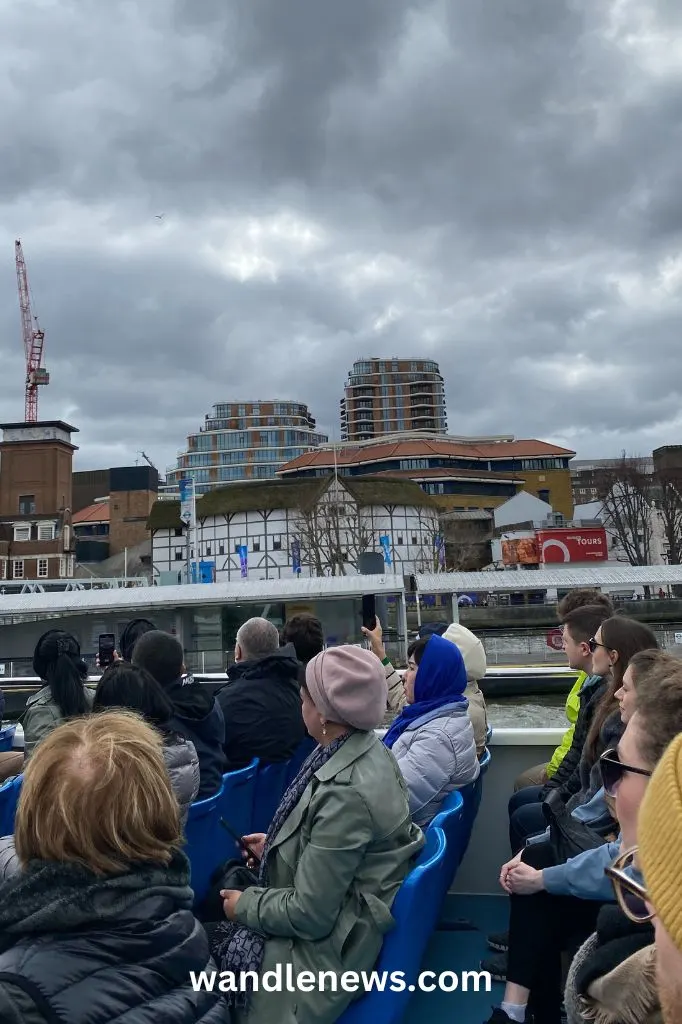
16. Southwark Cathedral
Southwark Cathedral is a historic Anglican cathedral located in the Borough of Southwark in London. It is one of the oldest Gothic churches in London, with some parts of it dating back to the 12th century when it was attached to a priory.
17. Fishmongers’ Hall
Fishmongers’ Hall is a livery hall, which serves as the headquarters of the Worshipful Company of Fishmongers. The hall has a long history dating back to the 14th century and has been rebuilt and renovated several times over the centuries. It is now used for a variety of events, including weddings, conferences, and banquets.
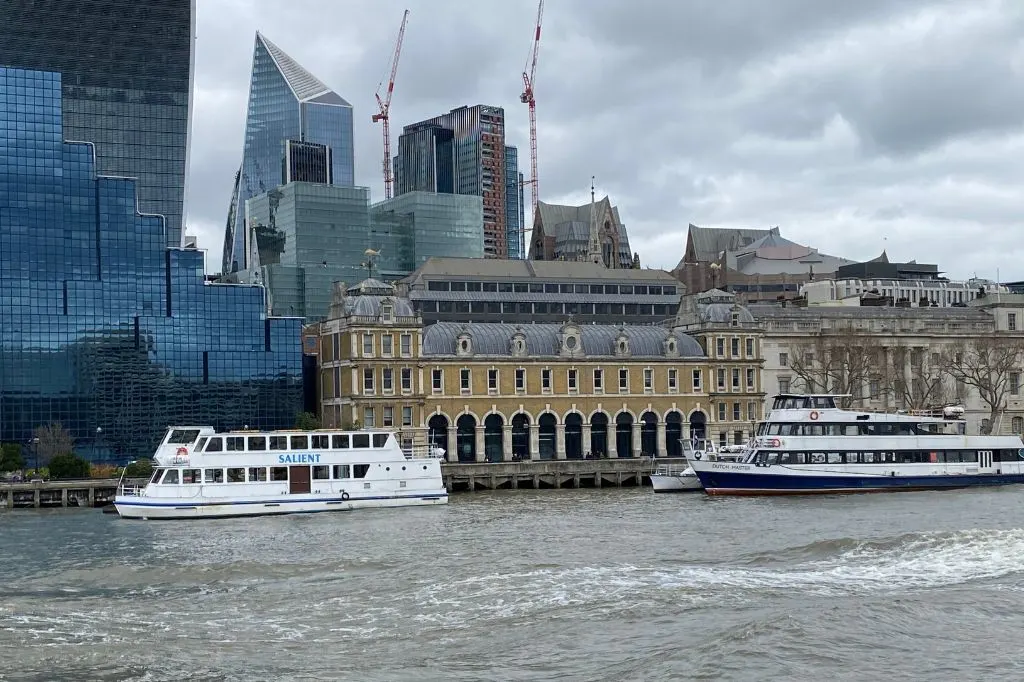
18. The Walkie Talkie
The Walkie Talkie, also known as 20 Fenchurch Street, is a skyscraper located in the financial district of London. It is known for its distinctive curved shape and sky garden, which offers panoramic views of the city. The building houses offices, restaurants, and a public observation deck.

19. The Shard
The Shard is a 95-story skyscraper located in Southwark. It is the tallest building in the United Kingdom and the fourth-tallest in Europe. The building contains offices, restaurants, a hotel, and an observation deck on the 72nd floor offering views of the city.

20. HMS Belfast
HMS Belfast is a historic warship permanently moored on the River Thames in London. It served in World War II and the Korean War and is now a museum, offering visitors a chance to explore the ship and learn about its history.

21. Tower of London
The Tower of London is a historic castle located on the north bank of the River Thames in central London. It has served as a royal palace, a prison, and a place of execution, and now houses the Crown Jewels. Facing the river is the Traitor’s Gate through which many famous prisoners have entered the Tower, never to leave.

22. St Katharine Docks
St Katharine Docks is a marina located in the London Borough of Tower Hamlets, which dates back to the 19th century. It was designed to handle particularly valuable cargo such as Ivory, tea and silver. It is now a commercial, residential and recreational area housing a marina and a number of restaurants. It was the first of London’s old docks to be transformed.
The Thames cruise finishes at this point, unless you are carrying on to Greenwich. This is an ideal location to disembark if you want to visit the Tower of London. It is also a ten minute walk from Tower Hill tube station.

Bridges on the Route
The Thames River Cruise passes under eight different bridges. These include Westminster Bridge, Hungerford and Golden Jubilee Bridges, Waterloo Bridge, Blackfriars Bridge, Millennium Bridge, Southwark Bridge, London Bridge and Tower Bridge. You can find out more about each of these bridges below.
Westminster Bridge
Westminster was the third bridge to be built over the Thames, after London and Putney Bridges. The present bridge was opened in 1862, and is painted green to match the seats in the House of Commons.
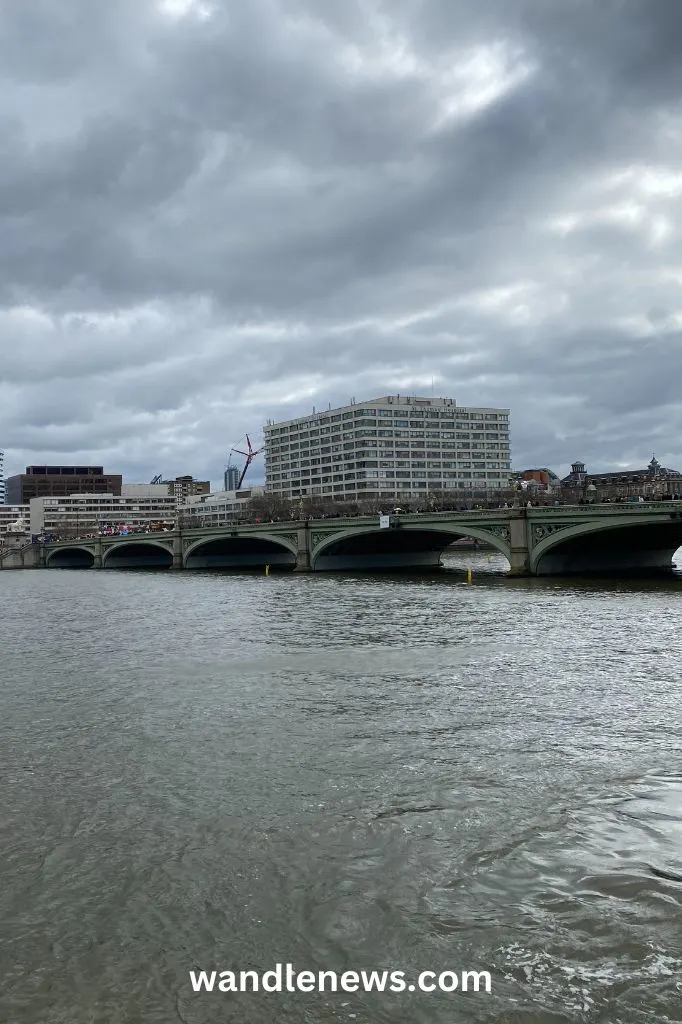
Hungerford and Golden Jubilee Bridges
Hungerford Bridge was originally a suspension footbridge, but was turned into a railway bridge to serve Charing Cross station. The footbridges on either side were opened in 2022 in celebration of the Queen’s Golden Jubilee.

Waterloo Bridge
Waterloo bridge was built mainly by women during the Second World War and is sometimes referred to as “The Ladies Bridge”.

Blackfriars Bridge
Blackfriars bridge was opened in 1869 by Queen Victoria. It has stone pillars shaped like pulpits of a church as a reminder of the 13th century Dominican friary that was once in the area. The friars’ black robes gave the area its name.

Millennium Bridge
Millennium Bridge is a footbridge that was originally opened in June 2000. On the day it opened the bridge started to wobble, so the bridge had to be closed and re-opened two years later. It is still referred to by Londoners as the “Wobbly Bridge”.

Southwark Bridge
Southwark Bridge is London’s least used bridge. This may be because the roads leading up to it are narrow, and people prefer to use nearby London Bridge. The original toll bridge that existed here in 1819 was also unpopular since nearby London Bridge was toll-free at the time.

London Bridge
London Bridge is the oldest river crossing in London, originally built by the Romans in 50AD. Since then it has been rebuilt multiple times. The current bridge was built in 1973 after the previous bridge was dismantled and shipped to Arizona, in the 1960s. London Bridge was once the only crossing on the Thames until Putney Bridge was built in 1729

Tower Bridge
Tower Bridge is a suspension bridge built between 1886 and 1894. The bridge was built to give better access to the East End of London, which in Victorian times had expanded its potential. The bridge had to be built as a suspension bridge to allow cargo ships to reach warehouses near London Bridge. The bridge still lifts several times a day to allow ships to pass through.

FAQs about the Thames River Cruise
Below you will find answers to the most frequently asked questions about the Thames river cruise.
How Long Does the Thames River Cruise Take?
A one way cruise from Westminster Pier to Tower Bridge takes 30 minutes. If you carry on until Greenwich, it takes 1 hour in total.
Circular cruises from Westminster to Greenwich take 2 hours for the round trip.

Where does the Thames River Cruise Start?
The Thames River Cruise starts at Westminster Pier, however if you book a package which includes the London Eye, you can board at London Eye Pier. The cruise I went on started at Westminster Pier, which is a short walk from Westminster Abbey and the Houses of Parliament. If you are travelling by tube, the nearest tube station is Westminster.
The photograph below shows the entrance to Westminster Pier.
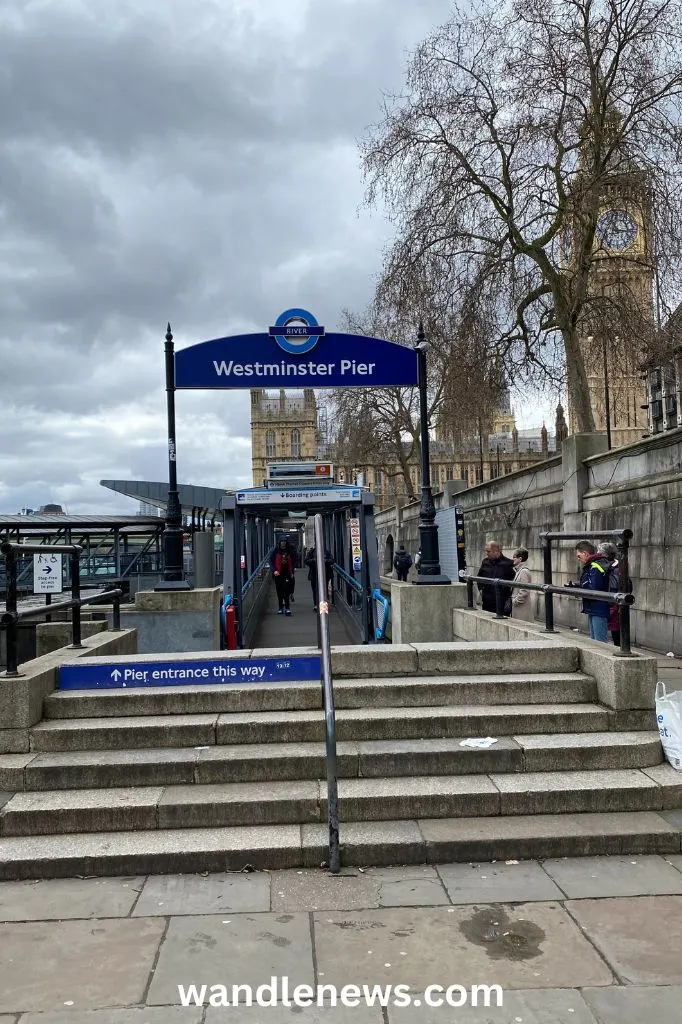
Once you enter Westminster Pier there are several different boarding points. Check your ticket to find out which boarding point you need.

Is There a Dress Code for Thames River Cruise?
The cruise that I went on did not have a dress code, but there is a dress code for other river cruises. The table below details what dress code is expected for different types of cruise.
| Cruise Type | Dress Code |
|---|---|
| Regular | None |
| Cruise with Afternoon Tea | Smart casual |
| Cruise with Dinner | Smart formal (no sports shoes or leisure wear) |
Check out the links below to find out what types of river cruise are available.
Do You Need to Book Thames River Cruise in Advance?
You don’t have to book the cruise in advance, but it is recommended that you do in order to avoid the queue, and guarantee a place on the boat. If you haven’t booked a ticket though, you can just turn up at the pier and buy one from the ticket office. I found that there was no difference in price.
If you choose to book a Thames river cruise, you will be given a list of departures times. Although this guarantees you a place on the boat at your chosen time, your ticket will still be accepted on any departure the same day.

What is the Best Thames River Cruise?
If you have never been to London before, I recommend getting the Thames River Cruise from Westminster to Greenwich. If you travel to Greenwich you will see other landmarks such as Cutty Sark, Canary Wharf, the Royal Naval College, and the Royal Observatory. You can check the availability for the Thames cruise to Greenwich below.
Is there a Toilet on Thames cruise?
Yes, all the boats have toilets, as well as a fully licensed bar selling hot and cold drinks, and snacks.
Other Relevant Posts
If you are visiting the river Thames you may find the following articles interesting and helpful.
- Why is the River Thames Brown?
- Why is the River Thames Important to London?
- What is a Mudlarking Experience on the River Thames?
- A Guide to the Queen’s Walk Along the River Thames
This Post was About Whether the Thames River Cruise Worth it
Thanks for reading my post about the London river cruise. The cruise is a great way to see many famous landmarks in London, without having to do loads of walking! If you decided to go on a Thames river sightseeing tour, please leave me a comment below and let me know if you thought the Thames river cruise was worth it.

DougP
Sunday 12th of January 2025
An excellent guide with heaps of interesting information and anecdotes about the sites along the river (I really liked the material on bridges - was Waterloo Bridge really built by women in WWII?) Keep up the good work, Olivia, we are all being spoiled. (Incidentally, are there any readers out there who learned to read at Old Central Primary School on Wimbledon Common, circa 1945-51?)
Judy R
Thursday 30th of March 2023
An excellent article for visitors and locals who have never taken a Thames cruise. Covers every aspect. My best experience was an organised cruise from Westminster to Hampton Court. Took four hours+, the commentary by an elderly boatman who obviously loved the river was entertaining and interesting. It rained of course, and was both hot, sunny and cold at times. Not enough tide to get through the gates at Teddington so had to wait at the lights. Altogether a tremendous experience. A bad experience was a short cruise about 25 years ago in an old tub with commentary by a lad who could barely speak English despite being London born. Embarrassing. Thank you.